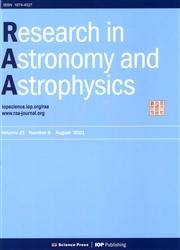SNR G1.9+0.3中的点对称性:摧毁其行星状星云原生体的超新星
IF 2.8
4区 物理与天体物理
Q3 ASTRONOMY & ASTROPHYSICS
引用次数: 0
摘要
我分析了银河系中最年轻的超新星残余物(SNR),即Ia型超新星残余物G1.9+0.3的新X射线图像,发现了一个非常明显的点对称结构。由于Ia型超新星(SNe Ia)的爆炸模型不会形成这种形态,因此点对称形态必须来自喷出物膨胀的星周物质(CSM)。我所发现的大尺度点对称性和已知的SNR G1.9+0.3喷出物的大幅减速都表明,CSM的质量相对较大,达到了≳1M⊙。我认为最有可能的解释是这个SN Ia爆炸成了一个行星状星云。预言PNe(SNIPs)内有大量SN Ia的情景是核心退化情景。其他的SN Ia情景可能只导致极小部分的SNIPs,或者根本没有。本文章由计算机程序翻译,如有差异,请以英文原文为准。
Point-symmetry in SNR G1.9+0.3: A Supernova that Destroyed its Planetary Nebula Progenitor
I analyze a new X-ray image of the youngest supernova remnant (SNR) in the Galaxy, which is the type Ia SNR G1.9+0.3, and reveal a very clear point-symmetrical structure. Since explosion models of type Ia supernovae (SNe Ia) do not form such morphologies, the point-symmetrical morphology must come from the circumstellar material (CSM) into which the ejecta expands. The large-scale point-symmetry that I identify and the known substantial deceleration of the ejecta of SNR G1.9+0.3 suggest a relatively massive CSM of ≳1M
⊙. I argue that the most likely explanation is the explosion of this SN Ia into a planetary nebula. The scenario that predicts a large fraction of SN Ia inside PNe (SNIPs) is the core degenerate scenario. Other SN Ia scenarios might lead to only a very small fraction of SNIPs or none at all.
求助全文
通过发布文献求助,成功后即可免费获取论文全文。
去求助
来源期刊

Research in Astronomy and Astrophysics
地学天文-天文与天体物理
CiteScore
3.20
自引率
16.70%
发文量
2599
审稿时长
6.0 months
期刊介绍:
Research in Astronomy and Astrophysics (RAA) is an international journal publishing original research papers and reviews across all branches of astronomy and astrophysics, with a particular interest in the following topics:
-large-scale structure of universe formation and evolution of galaxies-
high-energy and cataclysmic processes in astrophysics-
formation and evolution of stars-
astrogeodynamics-
solar magnetic activity and heliogeospace environments-
dynamics of celestial bodies in the solar system and artificial bodies-
space observation and exploration-
new astronomical techniques and methods
 求助内容:
求助内容: 应助结果提醒方式:
应助结果提醒方式:


